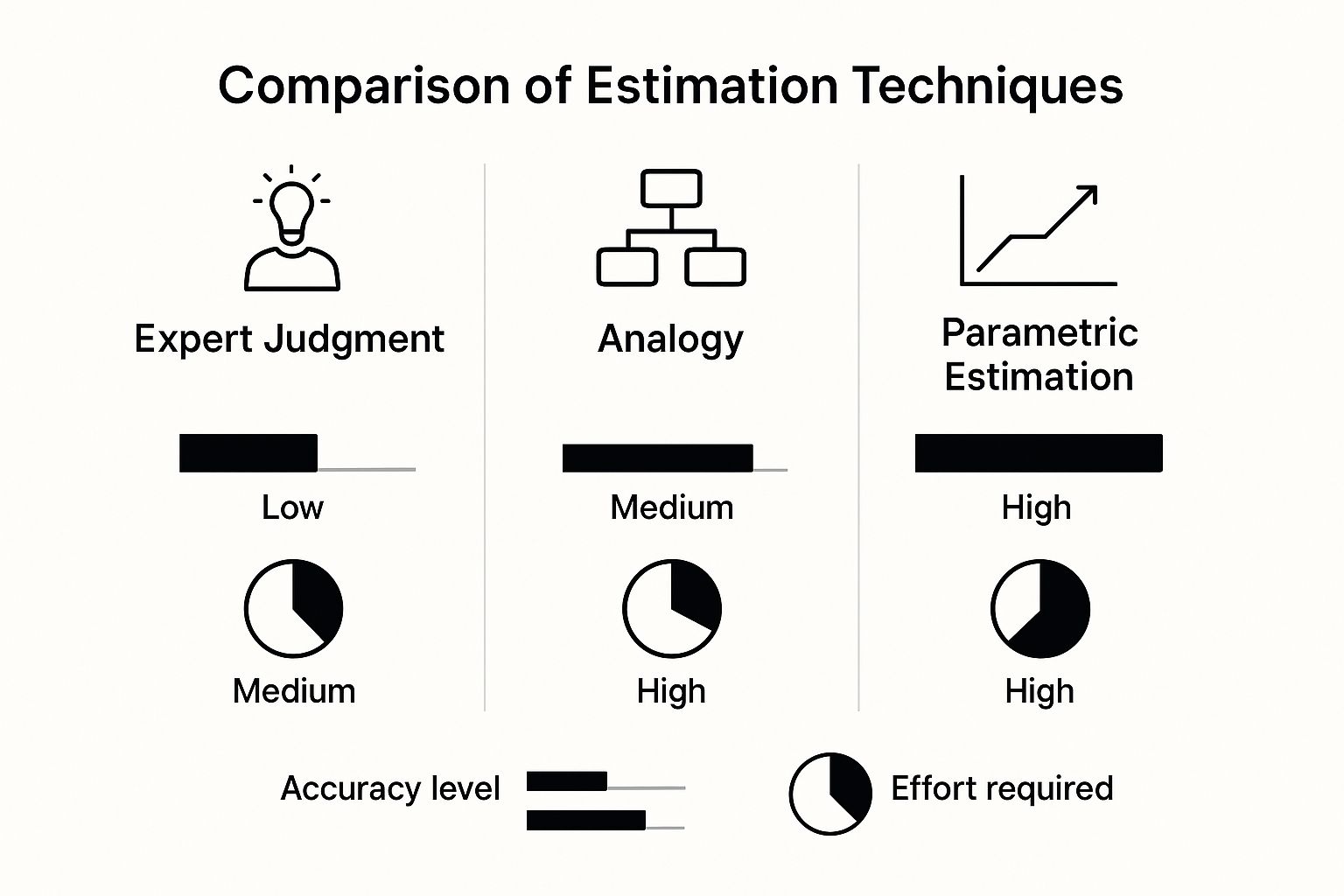Estimating Software Projects A Practical Guide
Ask any developer what their least favorite part of the job is, and you’ll often hear the same answer: estimating projects. It's the process of trying to predict the time, effort, and money needed to build a piece of software. In theory, you break down the project into smaller chunks and guess how long each will take. In reality, it's a notoriously tricky business, thanks to inherent uncertainty and the unforeseen complexities that always seem to pop up.
Why Software Project Estimates Are So Hard

Let’s be honest, estimating a software project can feel more like staring into a crystal ball than actual planning. We’ve all been there—giving a timeline with confidence, only to watch it crumble when unexpected roadblocks appear. Software development isn't like a predictable assembly line; it's a creative, problem-solving process full of "unknown unknowns."
The real challenge isn't just about adding up the hours for each task. It's about facing the statistical minefield of development, where one misunderstood or surprisingly complex feature can throw the entire project timeline off course.
The Amplifying Effect of Uncertainty
Simply adding up the "best guess" for each task is a surefire way to miss your deadline. The real timeline is always skewed by variability. For instance, research shows that if you have three tasks, each estimated at one week with just a little uncertainty, the actual average completion time is closer to five weeks.
But here’s the scary part: the 99th percentile—your absolute worst-case scenario—could stretch beyond 18 weeks. If just one of those tasks is more uncertain than the others, the average completion time can jump to over 10 weeks, and that worst-case scenario could balloon to an incredible 108 weeks. It’s a statistical phenomenon that shows just how quickly a "safe" estimate can become completely unrealistic.
This is why one seemingly small hiccup can cause a massive delay. It's not necessarily bad planning; it's just the nature of the work.
The goal isn't to find a magic number that's always right. It's to build a resilient plan that acknowledges and manages variability, turning uncertainty from a project-killer into a manageable risk.
Shifting Your Estimation Mindset
The secret is to stop chasing a single, perfect number. Instead, you need to start thinking in terms of possibilities and ranges. This is where different project management approaches can really make a difference. Understanding the trade-offs between different methodologies, like those discussed at https://makeautomation.co/project-management-waterfall-vs-agile/, gives you a framework for planning and estimating in a way that can handle change.
Ultimately, the headaches of estimation are tied to the bigger picture of running a project. Learning to navigate these challenges requires solid strategies for effective project management. It’s not about finding a foolproof method, but about getting better at identifying risks, accounting for the unknown, and building a plan that can bend without breaking.
Choosing The Right Estimation Technique
Picking the most fitting way to size up a software project boils down to your current situation—how much you know, where you are in the process, and what your team has tackled before. No single method works for every scenario, so it’s more about matching your needs with the strengths and trade-offs of each option.
Imagine you’re fixing up your home. You wouldn’t call in a structural engineer to repaint a wall. In the same vein, launching full-blown, bottom-up estimates when requirements are still fuzzy only creates extra work and guesswork.

You’ll notice a pattern: quick, low-effort approaches often come with wider margins of error, making them ideal for snapshots early on rather than for iron-clad plans down the road.
Early-Stage And High-Level Estimates
When details are scarce, aim for a Rough Order of Magnitude (ROM). These lightweight methods help stakeholders decide whether to greenlight the project without demanding hours of analysis.
-
Analogous Estimation
You lean on past projects to guide you. If your team rolled out a simple checkout flow in 4 weeks a few months ago, the next one will likely take about the same. It’s fast, but remember: no two efforts are carbon copies. -
Parametric Estimation
This is where data meets math. Suppose historical records show it costs $500 per feature to build, test, and launch. For 20 features, you’d estimate around $10,000. The catch is you need reliable, consistent data to make it stick. -
T-Shirt Sizing
A favorite in agile teams because it’s collaborative and avoids getting bogged down in numbers. Think of each story as XS, S, M, L, or XL. A “password reset” might be a Small, while “building a recommendation engine” feels like an XL.
Detailed And Data-Driven Estimates
As your vision sharpens, so should your estimation techniques. Diving deeper now pays off in more predictable delivery timelines.
One proven tactic is Three-Point Estimation, which forces you to challenge your gut and acknowledge uncertainty:
- Optimistic (O): Best-case scenario with no hiccups.
- Most Likely (M): What usually happens under normal conditions.
- Pessimistic (P): Everything that could go sideways does.
Running a quick PERT calculation—(O + 4×M + P)/6—gives you a weighted average that factors in risk.
A single number creates a false sense of certainty. A range, however, communicates reality. It acknowledges that software development is filled with unknowns and sets more realistic expectations with stakeholders from day one.
For the highest degree of accuracy, turn to Bottom-Up Estimation. Break the project into its smallest tasks, estimate each one, then roll them up into a final figure. It’s time-intensive, but when you have a crystal-clear scope, few methods beat its precision.
Comparison Of Software Estimation Techniques
Below is a quick reference to help you weigh each method’s sweet spot, advantages, and drawbacks.
| Method | Best For | Pros | Cons |
|---|---|---|---|
| Analogous Estimation | Early-stage, quick approval decisions | Super fast; leverages team’s past experience | Variances between projects can throw off your numbers |
| Parametric Estimation | Data-rich environments | More objective; scales with data | Demands high-quality historical records |
| T-Shirt Sizing | Rough agile sprints | Encourages team alignment; avoids over-precision | Lacks numeric granularity |
| Three-Point Estimation | Medium-fidelity roadmaps | Balances optimism with realism; includes risk margin | Needs consensus on scenarios; can feel abstract |
| Bottom-Up Estimation | Well-defined scopes nearing execution | Highest accuracy; task-level transparency | Most time-consuming |
Use this overview to zero in on the right approach for each phase of your project. Mixing and matching techniques often leads to better insights—and smoother delivery—than sticking with a single strategy from start to finish.
Breaking Down the Work for a More Accurate Estimate

Here’s a hard truth in software development: you can only estimate what you actually understand. Trying to put a number on a vague, high-level feature is just guesswork. The secret to a reliable estimate lies in breaking down those big, intimidating requirements into small, manageable tasks your team can wrap their heads around.
This deconstruction process is what turns a fuzzy goal into a clear, step-by-step plan. It’s a lot like trying to build a piece of furniture. You don't just "build a desk." You follow the instructions, attaching each leg, screw, and drawer one by one. Software estimation needs that same methodical approach.
Crafting a Work Breakdown Structure
The best tool I've found for this is the Work Breakdown Structure (WBS). It’s essentially a fancy term for a simple idea: take the total scope of the project and break it down into a hierarchy of smaller and smaller pieces until you have a list of concrete tasks.
Let's take a common requirement: "implement user authentication." That's a black box. It's impossible to estimate accurately on its own.
But once you start breaking it down, things get much clearer:
- UI/UX Design: Mockups for the login, registration, and password reset screens.
- Frontend Development: Build the responsive UI components for those screens.
- Backend API: Create endpoints for user registration, login validation, and session management.
- Database Schema: Design and build the 'users' table, making sure to include secure password hashing.
- Password Reset Flow: Handle token generation, email delivery, and the form to update the password.
Just like that, a huge feature becomes a series of distinct tasks. Now, a developer can look at each one and give a much more confident estimate because each piece is small enough to be fully understood.
Defining What "Done" Really Means
Breaking down the work is a huge step, but it's only half the battle. To keep scope creep in check and get everyone aligned, every single task needs a clear Definition of Done (DoD). A DoD is simply a checklist that confirms when a piece of work is truly complete.
A task without a Definition of Done is an open invitation for misunderstandings and endless revisions. It’s the difference between saying "build the login page" and "build a responsive, validated login page that passes all automated tests and has been approved by QA."
A solid DoD gets rid of ambiguity. It forces the team to think through all the necessary steps, including the "hidden work" that often gets forgotten, like writing tests, updating documentation, and performing code reviews. This ensures your estimates cover the full effort, not just the fun coding part. To get this right, you'll need to learn about https://makeautomation.co/mastering-documenting-requirements-in-agile/.
When you combine a detailed WBS with a strong DoD, you create a plan your team can actually believe in. Of course, this all hinges on having a good understanding of the project's goals in the first place, which is why mastering effective requirements gathering methods is so important. Get this foundation right, and you'll have more predictable timelines and a team that can deliver on its promises.
The Art of Iterative Estimation and Refinement

Let’s be honest: your first estimate is never your last. In fact, the most successful software projects I’ve been a part of treat those initial numbers as exactly what they are—a well-informed guess made with limited information.
The real magic happens when you stop thinking of an estimate as a stone tablet and start treating it like a living document. It's a continuous, iterative process of refinement.
This mindset shift is absolutely crucial for building trust with stakeholders. I've seen too many teams fall into the trap of giving a rosy, optimistic estimate just to get a project green-lit. What happens next is predictable: deadlines get pushed back again and again as reality sets in, eroding confidence and creating friction.
A much healthier, battle-tested philosophy is to start with a conservative, high-level estimate and then sharpen it as you learn more.
The Power of Starting High and Refining Down
A practical way to manage unknowns right from the start is to lean on your experience. For instance, you might initially propose a 24-month timeline for a new banking app, knowing there are a lot of unknowns.
But after a two-week discovery phase—prototyping, de-risking technical assumptions—you can often revise that estimate down to a much more accurate 12-month plan. This builds incredible credibility. It shows you're diligent and turns the estimation process into a series of wins instead of a source of constant disappointment. You can find a great discussion about project estimates and why no two are ever the same.
This iterative approach simply acknowledges a fundamental truth: you know the least about a project right at the beginning. As you move forward and your understanding grows, your estimates should reflect that newfound clarity.
When and How to Re-Estimate
Re-estimation shouldn't be a chaotic, reactive scramble. Instead, it should be a planned part of your project's rhythm. You need to build checkpoints into your timeline where the team can pause, review what they’ve learned, and update the forecast.
Here are a few perfect moments for refinement:
- After a discovery phase or Sprint Zero: Once you've done the initial research and prototyping, you have a much clearer picture of the real technical challenges and requirements.
- At the end of major milestones: Shipping a significant feature gives you hard data on your team's actual velocity and the true complexity of the work that's left.
- When a major change request is approved: Any significant change to the project scope must trigger a re-estimation. No exceptions.
Treating estimation as an ongoing dialogue rather than a one-time declaration completely transforms your relationship with stakeholders. It frames the process as a collaborative journey toward a shared goal, where adjustments are a sign of intelligent adaptation, not failure.
By communicating openly and refining estimates based on what you actually know, you keep the project on track without giving anyone whiplash. This helps you build a resilient plan that can handle the inevitable surprises that software development always throws your way.
Accounting for Hidden Work and Time Sinks
When we estimate a software project, it's dangerously easy to focus just on the coding. That’s like planning a road trip and only counting the hours you'll spend driving—completely ignoring the inevitable stops for gas, food, and the occasional surprise traffic jam. These "hidden" tasks are the time sinks that quietly derail even the most carefully laid plans.
A truly great estimate doesn't just guess at coding time; it makes all this invisible work visible from the start. It acknowledges that building quality software is a complex beast involving a lot more than just writing code.
The Real Cost of a Project
Industry data paints a clear picture of where the time really goes, and it's often not where you'd think. Before a single developer even boots up their IDE, the design and requirements analysis phases can eat up a massive chunk of the timeline.
For instance, it’s not uncommon for design to consume roughly 30% of the total project time, with another 25% spent on testing. To put that in budget terms, QA and testing alone can account for 26% of the entire software development budget. Think about that for a moment. If your estimate only covers the development hours, you’ve already missed over half of the actual effort needed to get the job done.
A Checklist for Uncovering Hidden Work
To build a forecast that can actually withstand contact with reality, you have to account for all the activities that orbit the core development work. Think of it less like a coding to-do list and more like a complete project inventory.
Here are some of the most common "hidden" tasks that absolutely need a line item in your estimate:
- Team Meetings: Daily stand-ups, sprint planning, retrospectives, and backlog grooming sessions. They all add up.
- Code Reviews: Peer reviews are non-negotiable for quality, but they take time from both the reviewer and the original developer who has to address the feedback.
- QA Cycles: This isn't a quick check. It involves manual testing, writing automated tests, running regression suites, and verifying bug fixes.
- User Acceptance Testing (UAT): The time your stakeholders need to actually review features and provide feedback is almost always underestimated.
- Deployment and DevOps: Setting up CI/CD pipelines, managing different environments, and pushing code to production requires dedicated effort.
Acknowledging these activities isn't about "padding" an estimate; it's about reflecting reality. When you budget time for meetings, reviews, and testing, you create a buffer that absorbs the natural friction of a project. This leads to far more predictable outcomes and fewer stressful conversations.
For a deeper dive into making these processes run smoothly, check out our guide on how to improve operational efficiency. Making these hidden costs visible from day one is the key to creating an estimate that holds up under pressure and prevents those painful, last-minute surprises.
Common Questions About Software Estimation
Even with the best techniques, a few tough questions always pop up during software estimation. These aren't just abstract problems; they're the real-world hurdles that project managers and dev teams have to clear every day. Getting solid, practical answers is what keeps things moving and builds confidence.
One of the most common challenges I see is trying to put a number on a project that’s full of unknowns. This is a classic trap. Teams feel pressured to produce a single, concrete number, even when the project scope is mostly fog.
How Do You Estimate a Project with Many Unknowns?
When you’re staring at a mountain of uncertainty, forcing a single-number estimate is a recipe for disaster. It’s far better to embrace the ambiguity and use a range.
A technique like Three-Point Estimation is perfect for this. You work out an optimistic, a pessimistic, and a "most likely" scenario. This approach gives stakeholders a much more realistic picture than one misleading number ever could.
I always recommend framing the initial work as a "discovery phase" or "sprint zero." The explicit goal isn't to build features but to clear the fog—clarify requirements, spike technical solutions, and knock down risks. You have to be upfront that your first estimate is just a rough order of magnitude (ROM) and that it will get sharper as the team learns more. This transparency builds trust right from the start.
Another hot topic, especially for teams new to agile, is the classic debate over how to size work.
What Is the Difference Between Story Points and Hours?
This one trips up a lot of people. Hours are an absolute measure. An eight-hour task should, in theory, take one person a full workday. Simple, right? But it's rarely that clean in practice.
Story points, on the other hand, are a relative measure. They bundle effort, complexity, and risk into a single number.
A 5-point story is simply bigger and more complicated than a 2-point story—the actual time it takes can vary. The real magic of story points is that they separate the conversation about effort from hard deadlines and how fast a specific developer works. This leads to more honest discussions and gives you a much better way to track the team's collective, long-term velocity.
Ultimately, good estimates come down to the team’s ability to forecast together, honestly.
The point of looking back at estimates isn't to assign blame. It's to learn as a team and get better at forecasting together. When you run blameless retrospectives, you build psychological safety, and that's when estimates really start to become reliable.
To get there, make sure the people doing the work are the ones providing the estimates. Use collaborative games like Planning Poker to get everyone talking and surface different perspectives. And here’s a crucial one: separate the estimate from the deadline. An estimate is a forecast, not a blood oath. Always hold blameless retrospectives to compare estimates to actuals, focusing on what you can learn, not who was "wrong."
At MakeAutomation, we specialize in implementing AI and automation frameworks that give your team the clarity and efficiency needed for more accurate project management. Eliminate guesswork and streamline your workflows. Book a discovery call today!







